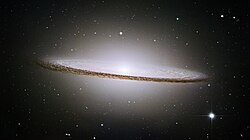Sary:Sombrero Galaxy in infrared light (Hubble Space Telescope and Spitzer Space Telescope).jpg

Haben'ny topi-maso: 800 × 448 teboka. Habe hafa: 320 × 179 teboka | 640 × 359 teboka | 1 024 × 574 teboka | 1 280 × 717 teboka | 3 000 × 1 681 teboka
Rakitra niaviana (3 000 × 1 681 teboka, haben'ilay rakitra : 3,98 Mio, endrika MIME : image/jpeg)
Tantara ny rakitra
Tsindrio eo amin'ny daty/ora iray mba hijery ny toetra n'ilay rakitra tamin'io fotoana io.
| Daty sy ora | saritapaka | Habe | Mpikambana | resaka | |
|---|---|---|---|---|---|
| ankehitriny | 20 Jolay 2009 à 20:46 |  | 3 000 × 1 681 (3,98 Mio) | Tryphon | {{Information |Description=NASA/ESA Hubble Space Telescope and NASA's Spitzer Space Telescope joined forces to create this striking composite image of one of the most popular sights in the universe. Messier 104 is commonly known as the Sombrero galaxy bec |
Fampiasana an'io rakitra io
Mampiasa ity rakitra ity io pejy io:
Fampiasan-drakitra maneran-tontolo
Mampiasa ity rakitra ity ireo wiki hafa ireo:
- Fampiasana eo amin'i ast.wikipedia.org
- Fampiasana eo amin'i az.wikipedia.org
- Fampiasana eo amin'i bs.wikipedia.org
- Fampiasana eo amin'i cs.wikipedia.org
- Fampiasana eo amin'i de.wikipedia.org
- Fampiasana eo amin'i en.wikipedia.org
- Conscience
- Wikipedia:Featured pictures
- Wikipedia:WikiProject Astronomy/Recognized content
- Wikipedia:Featured pictures/Space/Looking out
- User:Rsteilberg
- User:Rsteilberg/Userpage gallery
- Spitzer Infrared Nearby Galaxies Survey
- Wikipedia:WikiProject Astronomy/Recognized astronomy content
- User:The NMI User
- User:TaitAnderson
- User:EF5
- Wikipedia:Featured pictures thumbs/82
- Wikipedia:Featured picture candidates/December-2024
- User talk:EF5/Archives/2024/December
- Wikipedia:Featured picture candidates/Sombrero Galaxy in IR light
- Fampiasana eo amin'i en.wikiquote.org
- Fampiasana eo amin'i en.wikiversity.org
- Fampiasana eo amin'i es.wikipedia.org
- Fampiasana eo amin'i fa.wikipedia.org
- Fampiasana eo amin'i frp.wikipedia.org
- Fampiasana eo amin'i fr.wikipedia.org
- Fampiasana eo amin'i he.wikipedia.org
- Fampiasana eo amin'i id.wikipedia.org
- Fampiasana eo amin'i it.wikibooks.org
- Fampiasana eo amin'i kk.wikipedia.org
- Fampiasana eo amin'i kn.wikipedia.org
Hijery fampiasana eran-terikasan'ity rakitra ity.

